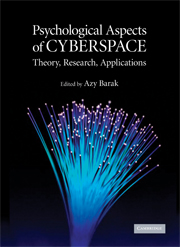Book contents
- Frontmatter
- Contents
- List of Tables
- List of Figures
- Preface
- List of Contributors
- 1 Reflections on the Psychology and Social Science of Cyberspace
- 2 Privacy, Trust, and Disclosure Online
- 3 Internet Abuse: Emerging Trends and Lingering Questions
- 4 Flow Experience in Cyberspace: Current Studies and Perspectives
- 5 Cybertherapeutic Theory and Techniques
- 6 Exposure in Cyberspace as Means of Enhancing Psychological Assessment
- 7 Down the Rabbit Hole: The Role of Place in the Initiation and Development of Online Relationships
- 8 The Sexy Side of the Internet: An Examination of Sexual Activities and Materials in Cyberspace
- 9 The Contact Hypothesis Reconsidered: Interacting via Internet: Theoretical and Practical Aspects
- 10 Influences on the Nature and Functioning of Online Groups
- 11 Online Motivational Factors: Incentives for Participation and Contribution in Wikipedia
- 12 How Internet-Mediated Research Changes Science
- Index
- References
8 - The Sexy Side of the Internet: An Examination of Sexual Activities and Materials in Cyberspace
Published online by Cambridge University Press: 05 June 2012
- Frontmatter
- Contents
- List of Tables
- List of Figures
- Preface
- List of Contributors
- 1 Reflections on the Psychology and Social Science of Cyberspace
- 2 Privacy, Trust, and Disclosure Online
- 3 Internet Abuse: Emerging Trends and Lingering Questions
- 4 Flow Experience in Cyberspace: Current Studies and Perspectives
- 5 Cybertherapeutic Theory and Techniques
- 6 Exposure in Cyberspace as Means of Enhancing Psychological Assessment
- 7 Down the Rabbit Hole: The Role of Place in the Initiation and Development of Online Relationships
- 8 The Sexy Side of the Internet: An Examination of Sexual Activities and Materials in Cyberspace
- 9 The Contact Hypothesis Reconsidered: Interacting via Internet: Theoretical and Practical Aspects
- 10 Influences on the Nature and Functioning of Online Groups
- 11 Online Motivational Factors: Incentives for Participation and Contribution in Wikipedia
- 12 How Internet-Mediated Research Changes Science
- Index
- References
Summary
“Every technological innovation creates deviant as well as respectable possibilities” (Edgley & Kiser, 1981, p. 59). Edgley and Kiser (1981) were referring to “Polaroid sex,” that is, instant photography methods used to create homemade pornography. A quarter of a century later, this statement may equally be applied to the Internet. Ever since the beginnings of the World Wide Web, people have engaged in online sexual activities. These activities include, but are not limited to, cybersex, hot chatting, locating others to have sex with offline, seeking information or advice about sexual health, romance and relationships, downloading pornography, and purchasing erotic materials.
In this chapter, we explore the many types of available online sexual activities and the types of people who engage in these activities. We also examine the pros and cons of the sexy side of the Internet. On the one hand, we argue that the Internet can be used to explore one's sexuality, but on the other, some people become too obsessed with engaging in online sexual activities. Importantly, the Internet can also be used to educate both adolescents and adults about sexual issues. Finally, this chapter turns to examine the future of online sexual activities.
The Beginnings of Internet Sex
People have been engaging in Internet sexual activities since its inception. Although at first individuals were limited to textual exchanges, many found no difficulties with talking “dirty” online and reconstructing the body online.
- Type
- Chapter
- Information
- Psychological Aspects of CyberspaceTheory, Research, Applications, pp. 185 - 208Publisher: Cambridge University PressPrint publication year: 2008
References
- 2
- Cited by



